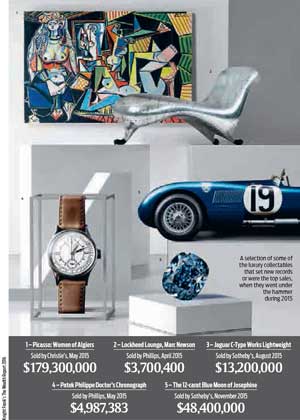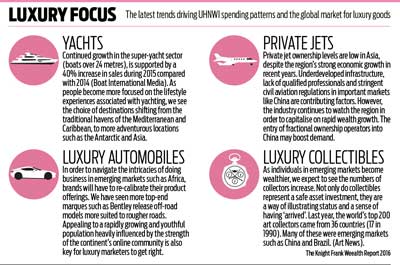
Whether it is art, classic cars, a piece of jewellery or even football teams, the UHNWI’s hunger to collect the world's most desirable objects seems stronger than ever.
Classic cars continue to top with an annual growth of 17% and furniture once again brings up the rear at -6%. While no classic car managed to beat Bonhams' 2014 record (when a 1962 Ferrari 250 GTO Berlinetta was auctioned for $38 million), eight of the 25 cars ever to have sold for over $10 million at auction went under the hammer in 2015. These included all-time-high results for Jaguar ($13.2 million), Porsche ($10.1 million) and McLaren ($13.75 million). However, according to Dietrich Hatlapa, of analyst HAGI, growth is slowing and considerably lower than for the 12 months to September 2014, when the HAGI Top Index zoomed up by 25%.
Having bid $48.4 million for the Blue Moon diamond auctioned by Sotheby's Geneva, a Hong Kong-based billionaire set an all-time record for a gem or piece of jewellery, in November. The previous day, he paid $28.5 million for a vivid pink diamond sold by Christie’s.
When it comes to art, Paul Gauguin's painting 'When Will You Marry?' became the most expensive work of art ever sold at $300 million and Picasso's 'Women of Algiers’ set a new record for a painting sold at auction, at $179 million. Other artists, including Modigliani ($170 million) and Twombly ($70.5 million), also scored high.
Wine also had a good year with the Knight Frank Fine Wine Icons Index up by 5%.

Image courtesy: Knight Frank's The Wealth Report 2016
The index is based on the proportion of UHNWIs from each of the principal geographic regions who own at least one of the following luxury assets—yachts, private jets, collectables (fine wine, antiques, art, jewellery and watches), and a luxury automobile worth more than $100,000. This allows a comparison of the likelihood of an UHNWI from a particular region owning a luxury asset against the global average.
Currently, North American UHNWIs are below the global average for yacht ownership, but thanks to the high levels of wealth in the US, yacht ownership is expected to increase. Countries in the Pacific and Europe tend to have a greater affinity with the sea as compared to Asia, while UHNWIs in Africa and Latin America have a stronger inclination toward private jet ownership (2.0x and 1.59x respectively) than the global average.
Within Africa, the number of UHNWIs with a luxury automobile is 1.55x the global average. Difficult economic conditions have not diminished the appetite of wealthy collectors. In fact, during periods of economic uncertainty, many wealthy individuals in emerging markets look for tangible investments such as paintings (particularly the contemporary, modern and impressionist genres), which will appreciate in value. The Wealth-X Luxury Spending Index shows that European UHNWIs are almost twice as likely to own a collectable compared with the global average, while UHNWIs in Asia and Latin America are below the global average.

Image Courtesy: Knight Frank's The Wealth Report 2016
A new generation of young, wealthy entrepreneurs and business people are keen on investing their money in new ways—one such area of interest being sports, particularly football. After Russian billionaire Roman Abramovich became the owner of Chelsea FC in 2003, there has been a growing list of investors interested in football clubs, including Sheikh Mansour, the owner of Manchester City and Les Scadding, the owner of Newport County AFC. Why? There is money to be made. How?
Deloitte's annual Review of Football Finances show that English Premier League (EPL) revenues rose from £2.5 billion to £3.3 billion (29%) last year. In February 2015, the league sold television rights to its games for £5 billion, 71% above the previous deal. It is projected that from the 2016-17 season, even the bottom club in the league can expect around £100 million in central prize money, each season (up from £62m now) and the highest earning club can expect around £156m (up from £97.5m).
Apart from broadcasting, another key revenue stream is ticket sales. Shirt deals, stadium rights and major sponsorship deals on a regional or global level are profitable too. Other properties for sale include stadium-naming rights, training-kit deals and leisurewear partners. The list, the potential and therefore the income, is almost endless.